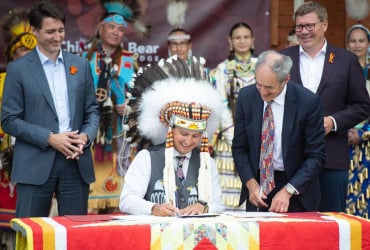As Kevin Estrada boated through flooded farmland while helping neighbors during the British Columbia climate disaster, he noticed salmon struggling through tall grass and flowing water.
“I noticed that there were some stranded salmon in the farmers’ fields due to the bogs that were overflowing,” said Estrada, owner of Chilliwack’s guide business, Sturgeon Slayers, who did what he could to save them.
He carefully collected the fish and carried them back to the river.
“I tried to move them to where they should be, but you know, it’s still overwhelmed,” he said.
Estrada said he rescued about 10, but wonders how many are still out there.
What people are reading

The fish were found in the Sumas Prairie area of Abbotsford, which suffered severe flooding that forced hundreds of residents and their livestock to evacuate. Thousands of the farm animals could not get out and died. The area was once home to Lake Sumas, an area vital to the Sumas First Nation before settlers drained it for use as farmland.
The Fraser Valley flood was caused by an atmospheric river, which saw heavy rains in southern British Columbia due to climate change, exacerbated by a summer of wildfires and clear felling practices. The meteorological event triggered evacuations, stranded people and caused at least one death.
Salmon have been seen in flooded agricultural fields and swimming around picnic benches in parks. There are numerous setbacks that the weather event could have on the province’s population, said @AaronHill_ of @WatershedWatch_.
The high tide has Aaron Hill, executive director of the Watershed Watch Salmon Society, especially concerned for the well-being of the province’s already precarious salmon population. Although some have already crossed the river system to the ocean, the spawning seasons of other species last until November. It means there are salmon, like the ones Estrada saw in Abbotsford, struggling to finish their run and freshly laid eggs that may be being thrown.
Although Hill says that floods are a natural part of a river system, he stressed that the timing and severity of the BC event are not good.
“The moment of this [flood] it’s really devastating because it’s happening when there are freshly laid eggs in the gravel and the fish are still spawning, ”he said.
“… What happens is that the gravel is washed away by the raging water and by the landslides and the trees and things that come down the river, and then silt is deposited on the gravel beds to suffocate the eggs.”

The survival of the eggs is the most important thing to Hill, as is the stranded salmon. Point to the “poor friend” seen swimming between picnic tables on Vancouver Island and says there are surely many more like them who could die once the waters recede.
Hill is especially concerned about the chum, who are currently spawning. Juvenile coho and chinook that inhabit waterways are also vulnerable at this time, he said.
“… When one [species] takes a really hard hit, usually there are still a few others that can survive. But the problem with what has happened here is that our populations are already at such low levels of abundance that they have very little cushioning to absorb shocks like this, “he said.
It’s too early to say exactly how the flooding will affect salmon, Hill said, but he notes that pollutants like fertilizers from farmland and other road pollutants could poison waterways. He said he has heard from volunteers on the ground that toxic waste is accumulating in the flood zone, from oil spills, human and animal waste, dead animals and garbage. All are returned to the river and salmon habitat.
As people like Hill prepare to take stock of how the floods affected salmon, he said it is important to think about what caused the floods and how we are going to update our infrastructure to make it more resilient.
In Sumas Prairie, pumping stations like the Barrowtown facility (which narrowly avoided failures this week) are responsible for keeping water out of the land, but pose additional problems for fish. The stations are located along the Fraser River and keep water out of farmland and stream levels. However, they are also responsible for damaging the salmon population: if the fish pass through them, they die.
Many pump stations need to upgrade their infrastructure in the near future, and that’s an opportunity to make them more salmon-friendly, he said.
“It’s also very important to hear the big picture: this is happening because of human-caused climate change. We are receiving more intense and frequent flooding. And that’s something that has been predicted for a long time, ”he said.
“And we know that our flood infrastructure in lower Fraser is not up to scratch. We have known it for a long time. “
Reference-www.nationalobserver.com